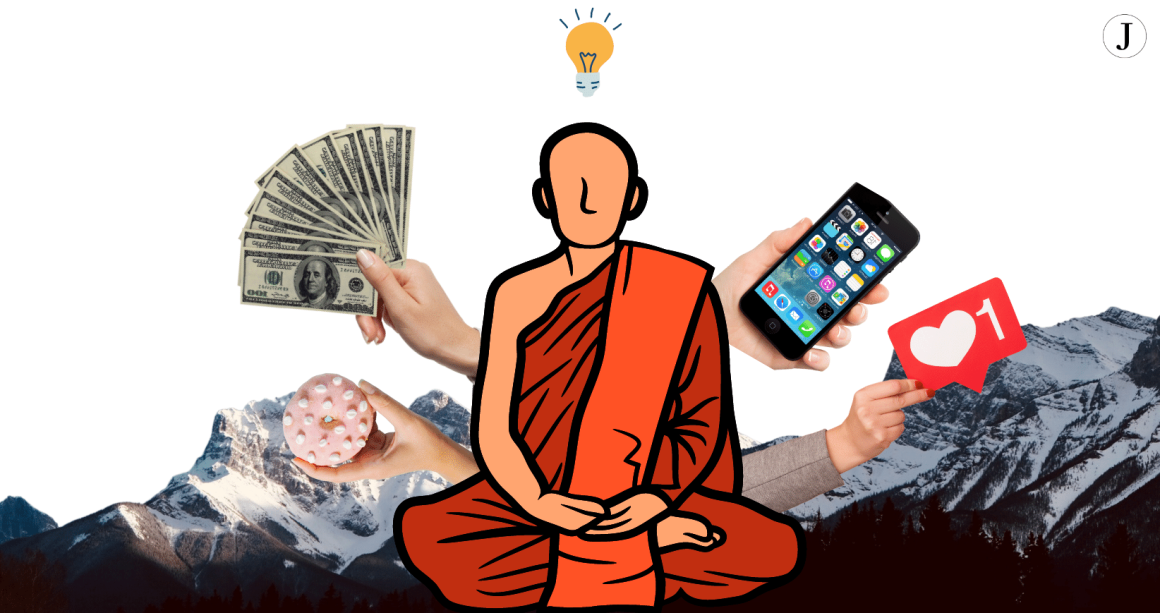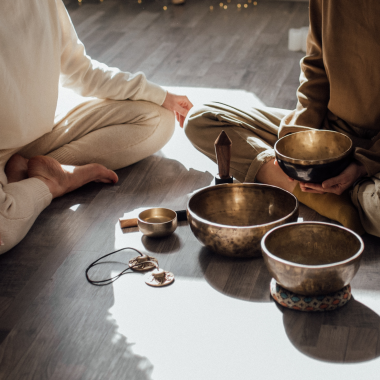written by Julstory editors
Do you often find yourself lost in the frenzied pace of today’s world? Exhausted by the relentless flood of notifications, incessant digital chatter, and never-ending tasks? Rest assured, you’re not alone in this struggle.
So, what is the solution? It might just be something called monk mode. This practice offers an escape from the commotion, a pathway to inner calm, and an opportunity to seize back control over your precious time and focus. In this article, we’re going to navigate through the world of monk mode, exploring its principles, potential advantages, and how you can integrate it into your own life.
What is Monk Mode?
Monk mode is a lifestyle approach where an individual minimizes distractions, fosters solitude, and focuses intensely on personal goals. It’s a way of life that emphasizes simplicity, mindfulness, and profound focus, mimicking the way monks live and work.
How to Go Monk Mode
The monk mode challenge requires dedication and commitment. However, before delving into the monk mode habits, it’s crucial to understand that each person’s experience might be different. Here’s a basic framework to kickstart your monk mode journey:
- Digital Detox: Limit the time spent on digital devices, particularly on social media. In our digitally saturated lives, constant notifications and endless scrolling can be a significant source of distraction and anxiety. Make a deliberate choice to limit your time on digital devices, particularly social media. This step alone can significantly reduce mental clutter and free up time for more meaningful pursuits.
- Healthy Routines: Engage in regular exercise and maintain a balanced diet. Regular physical exercise not only promotes health but also aids mental well-being by reducing stress. Complement this with a balanced diet that nourishes both your body and mind, providing the energy you need to focus on your goals.
- Meditation and Mindfulness: Spend time each day in silence, reflection, and mindfulness. Spending time each day in silence and reflection fosters a deeper connection with oneself, heightening self-awareness and fostering inner peace. Mindfulness, the practice of being present in the moment, can enhance concentration and make daily tasks more fulfilling.
- Pursue Personal Growth: Focus on reading, learning, and other activities that promote personal development. Make a concerted effort to pursue personal growth. This pursuit could be reading insightful books, learning a new skill, or simply indulging in a hobby that promotes creativity. Focusing on such activities enhances mental agility and opens the mind to new ideas and perspectives.
Entering monk mode is a journey, a transformation that fosters tranquility, sharpens focus, and boosts productivity. Embrace this path and discover the profound impact it can make on your life.
The Benefits: Monk Mode Productivity
The question inevitably arises – does monk mode work? The answer is yes, especially in fostering productivity. Monk mode productivity is all about deep work – a state of flow where the individual’s productivity skyrockets, and quality work gets accomplished. This productivity surge results from a reduction in distractions, leading to improved focus and concentration.
Rules and Habits: Adopting the Monk Mode Lifestyle
The monk mode rules are not rigid or definitive. Instead, they serve as guidelines to achieve simplicity, inner peace, and productivity. Let’s look at a few of these rules:
- Isolation: Isolate yourself from unnecessary noise and distractions. This does not necessarily mean physically removing oneself from society or living a hermit’s life. It’s more about creating a personal space, free from unnecessary distractions and noise. This might involve defining certain hours for deep work, creating a quiet and clutter-free workspace, or using tools that limit digital interruptions.
- Mindfulness: Be present in every task you undertake. It is about immersing oneself entirely in each task, moment by moment. From sipping a cup of tea to writing a business proposal, mindfulness cultivates an intense presence that elevates the experience and enhances the quality of the task at hand. Incorporating mindfulness into daily life encourages appreciation of the present, reduces stress, and boosts overall life satisfaction.
- Inner Peace: Cultivate peace through meditation and other forms of mental relaxation. This can be achieved through various means such as meditation, yoga, or even a simple walk in nature. The goal is to calm the mind, promoting mental clarity and a sense of tranquility. By practicing such activities regularly, you foster an inner sanctuary of peace that can provide resilience against stress, anxiety, or negativity.
- Focus: Keep your attention on your personal goals and productive tasks. With the world vying for our attention, it’s easy to get pulled in different directions, leading to a scatterbrain effect. In monk mode, you’re encouraged to direct your attention to what truly matters, whether it’s a personal project, a professional goal, or a learning endeavor. This focus helps in prioritizing tasks, reducing procrastination, and enhancing productivity.
In essence, these rules are the foundational pillars of the monk mode lifestyle, serving as your compass in this journey towards simplicity, inner peace, and productivity. They guide you in transforming your habits, refining your focus, and reshaping your life.
Reading Material: Books on Monk Mode
Several books on monk mode offer insights and practical advice on adopting this lifestyle. A variety of books delve into this lifestyle, providing both theoretical knowledge and practical advice.
- “Deep Work” by Cal Newport: This book delves into the power of focused work. It provides strategies to develop the ability to concentrate without distraction, thereby enhancing productivity and satisfaction in your work – a core principle of monk mode.
- “Digital Minimalism” by Cal Newport: Newport expands on his ideas in “Deep Work” by discussing ways to declutter our digital lives. He emphasizes the importance of reducing time spent on digital platforms and regaining control over our attention, aligning with the monk mode philosophy.
- “The Power of Now” by Eckhart Tolle: While not explicitly about monk mode, this book offers invaluable insights into the art of mindfulness, encouraging readers to live in the present moment, a key aspect of monk mode.
- “The Miracle of Mindfulness” by Thich Nhat Hanh: This seminal work explores the practice of mindfulness in everyday life. Its teachings mirror the monk mode’s emphasis on being present in every task and moment.
These insightful books serve as comprehensive guides, offering both theoretical knowledge and practical strategies to effectively incorporate the monk mode lifestyle into your everyday life.
Monk Mode Schedule
The Monk Mode schedule incorporates practices that nourish the mind, body, and soul. This is more than a schedule, it’s a pathway towards your best self:
4:30 AM – 5:00 AM: Rise Early – Monk Mode begins with an early start. This quiet time is used for reflection and setting intentions for the day.
5:00 AM – 6:00 AM: Meditation – This hour is dedicated to meditation, cultivating mindfulness and inner peace.
6:00 AM – 7:00 AM: Exercise – Physical activity, whether it’s a series of yoga poses or a brisk walk, gets the blood flowing and energizes the body for the day ahead.
7:00 AM – 8:00 AM: Nutritious Breakfast – A simple, plant-based meal provides nourishment for the body and mind.
8:00 AM – 12:00 PM: Focused Work – This time block is for undistracted, deep work. Depending on individual goals, it might include studying, writing, or other productive pursuits.
12:00 PM – 1:00 PM: Mindful Lunch – Like breakfast, lunch is nutritious and consumed mindfully, fostering a deep appreciation for the food that sustains us.
1:00 PM – 5:00 PM: Continued Focused Work – The afternoon continues the morning’s deep work session, punctuated by brief breaks to rest the mind and maintain focus.
5:00 PM – 6:00 PM: Reflection & Planning – This time is used to review the day’s accomplishments, learn from any challenges, and plan for the next day.
6:00 PM – 7:00 PM: Light Physical Activity – A light walk or some yoga poses help to relax after the day’s work and transition into the evening.
7:00 PM – 8:00 PM: Meditation – Another round of meditation helps to quiet the mind at the end of the day.
8:00 PM – 8:30 PM: Preparation for Rest – A routine of preparing for bed signals to the body that it’s time to wind down.
8:30 PM: Sleep – The day ends with a good night’s sleep, allowing the body and mind to rest and rejuvenate for the next day.
Remember, this is just an example of a Monk Mode schedule. The actual timings and activities can be adjusted based on personal needs and circumstances. The key element is the commitment to deep focus, minimalism, and self-improvement.
The Monk Mode Transformation
Monk mode might seem daunting, but its ultimate goal is to regain control over your life and find inner harmony. It’s about prioritizing your goals, focusing on what matters most, and finding peace amid the chaos. Whether you’re seeking to enhance productivity or craving a quieter, simpler existence, going monk mode could be the answer you’re looking for.
Remember, the journey is personal. It’s your monk mode. Make it what you need it to be.








